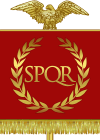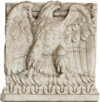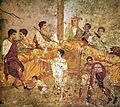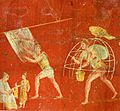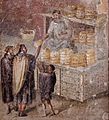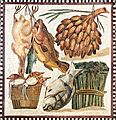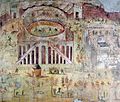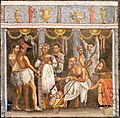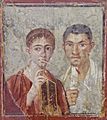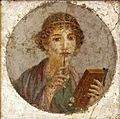Roman Empire facts for kids
Quick facts for kids
Roman Empire
|
|||||||||||
|---|---|---|---|---|---|---|---|---|---|---|---|
| 27 BC – 476 AD (traditional dates) 395 AD - 480 AD (Western) 395 AD – 1453 AD (Byzantine) |
|||||||||||
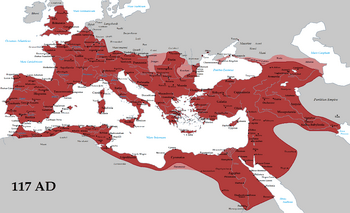
|
|||||||||||
| Capital | |||||||||||
| Common languages | |||||||||||
| Religion |
|
||||||||||
| Government | Semi-elective, functionally absolute monarchy | ||||||||||
| Emperor | |||||||||||
|
• 27 BC – 14 AD
|
Augustus (first) | ||||||||||
|
• 98 AD – 117 AD
|
Trajan | ||||||||||
|
• 270 AD – 275 AD
|
Aurelian | ||||||||||
|
• 1449 – 1453
|
Constantine XI | ||||||||||
| Legislature | Senate | ||||||||||
| Historical era | Classical era to Late Middle Ages | ||||||||||
| 32 BC – 30 BC | |||||||||||
|
• Empire established
|
30 BC – 2 BC | ||||||||||
|
• Constantinople
becomes capital |
11 May 330 AD | ||||||||||
|
• Final East-West divide
|
17 January 395 AD | ||||||||||
| 4 September 476 AD | |||||||||||
|
• Murder of Emperor Julius Nepos
|
25 April 480 AD | ||||||||||
| 12 April 1204 | |||||||||||
|
• Reconquest of Constantinople
|
25 July 1261 | ||||||||||
| 29 May 1453 | |||||||||||
|
• Fall of Trebizond
|
15 August 1461 | ||||||||||
| Area | |||||||||||
| 25 BC | 2,750,000 km2 (1,060,000 sq mi) | ||||||||||
| 117 AD | 5,000,000–6,500,000 km2 (1,900,000–2,500,000 sq mi) | ||||||||||
| 390 AD | 4,400,000 km2 (1,700,000 sq mi) | ||||||||||
| Population | |||||||||||
|
• 25 BC
|
56,800,000 | ||||||||||
| Currency | Sestertius, Aureus, Solidus, Nomisma | ||||||||||
|
|||||||||||
The Roman Empire was one of the biggest and most powerful empires in the ancient world. Its capital city was Rome. The empire was centered around the Mediterranean Sea. It began around 27 BC when Octavian became the first Emperor, Augustus. The Western Roman Empire officially ended in 476 AD. This event marked the end of the ancient world and the start of the Middle Ages.
The Roman Empire was the third main stage of Ancient Rome. Before the emperors, Rome was ruled by kings, then by the Roman Republic. Many modern countries were once part of the Roman Empire. These include Britain (but not Scotland), Spain, Portugal, France, Italy, Greece, Turkey, parts of Germany, Egypt, The Levant, Crimea, Switzerland, and the northern coast of Africa.
The main language spoken in the Roman Empire was Latin. Greek was also very important, especially in the eastern parts of the empire. The western half of the Roman Empire lasted for about 500 years. It ended when a general named Odoacer removed the last emperor, Romulus Augustus. However, the eastern half, known as the Byzantine Empire, continued for about another thousand years. Its capital was Constantinople, which is now called Istanbul.
Contents
How Did the Roman Empire Work?
To manage their huge empire, the Romans developed important ideas about law and government. They had the best army in the world at that time and used it to keep control. They were also amazing engineers. They built many roads, cities, and impressive buildings.
The Empire was divided into different provinces. Each province had a governor who was in charge. There were also civil and military officials to help. Messages, both official and private, were constantly sent to and from Rome.
Trade and Daily Life in Rome
Trade was very important for Rome. It was a city of over a million people, making it the largest city in the world. They needed goods from all over the empire. For example, they got wheat from Egypt, tin from Britain, and grapes from France.
In return, the Romans helped the provinces. They built beautiful cities, protected them from attacks by barbarians, and offered education. Young people in the provinces could also find jobs, like joining the Roman army.
The Role of the Emperor
In theory, Roman emperors had total power. They could do whatever they wanted. But in reality, they faced many difficult challenges. They had a team of civil servants and received advice from the Roman Senate.
The emperor had to decide what problems were most important for the Empire. They usually focused on two main things:
- Improving life for Romans during times of peace.
- Fighting and defeating Rome's enemies. A rich empire always has enemies!
Choosing a New Emperor
A big problem for emperors was deciding who would rule next. Sometimes, a king's eldest son would take over if he was a good leader. For Roman emperors, it was often an adopted son.
Here is how it sometimes worked: An emperor would notice a talented young man from a good family. He would then adopt him as his son. Before dying, the emperor would make it clear who he thought should be the next ruler. This might be by making him a Roman consul or stating it in his will. Sometimes this plan worked, but sometimes it did not. Every now and then, there would be a civil war between different people who wanted to be emperor.
Having an adopted son gave the emperor more choices. Some emperors had no sons, or their sons died young. Later, emperors became so weak that the Roman army would simply choose one of their generals to be the next emperor. This often led to more civil wars. You can find the life stories of the emperors in the List of Roman emperors.
Roman Culture and Achievements
The Romans fought many wars against other countries. They also enjoyed watching exciting and sometimes violent sports. They loved watching races between chariots pulled by horses. They also watched fights between men using weapons, known as gladiators. Unlike modern sports, these fighters were often killed. Romans enjoyed these shows in large arenas like the Colosseum.

The Romans were masters of civil engineering. They built many large public buildings and villas. They also constructed aqueducts to carry water, stone bridges, and roads. Some of these amazing structures can still be seen today. Many famous writers were Romans, including Cicero and Virgil.
Christianity in the Roman Empire
The New Testament of the Bible tells us about the Romans during the life of Jesus Christ. At that time, the Romans were pagan (meaning they believed in many gods) and ruled Jesus's country. Later, several emperors tried to stop Christianity, but they did not succeed.
By 312 AD, the emperor Galerius allowed people to freely follow Christianity. The next year, a general named Constantine became emperor and converted to Christianity himself.
Why Did the Roman Empire Decline?
The city of Rome was attacked and taken over several times by barbarians. A famous event was in 410 AD, when the Goths attacked and looted the city. The last Western Roman emperor, Romulus Augustus, stepped down in 476 AD. However, the Roman Empire continued for another 1,000 years in the east as the Byzantine Empire.
The main coin of the Roman Empire was the silver denarius. Later versions of the denarius became smaller.
Many reasons have been suggested for why Rome fell. Edward Gibbon wrote a famous book called The Decline and Fall of the Roman Empire. In it, he explored different ideas. He believed that Christianity weakened the Empire's ability to defend itself militarily.
Other historians blame the unstable system of leadership. In one 50-year period, only 2 out of 22 emperors died a natural death. Most of the emperors were assassinated.
Images for kids
-
The Barbarian Invasions involved the movement of ancient Germanic peoples into Roman territory.
-
A segment of the ruins of Hadrian's Wall in northern England.
-
Bilingual Latin-Punic inscription at the theatre in Leptis Magna, Roman Africa.
-
A family banquet depicted on a wall painting from Pompeii (1st century AD).
-
Citizen of Roman Egypt (Fayum mummy portrait).
-
Slave holding writing tablets for his master (relief from a 4th-century sarcophagus).
-
Fragment of a sarcophagus depicting Gordian III and senators (3rd century).
-
A green Roman glass cup found in a tomb in Guangxi, southern China.
-
Landscape from the ruina montium mining technique at Las Médulas, Spain, a major gold mine.
-
Roman hunters preparing traps and hunting near Tarraco.
-
The Pont du Gard aqueduct in southern France, a UNESCO World Heritage Site.
-
Aquae Sulis in Bath, England.
-
Public toilets (latrinae) from Ostia Antica.
-
Still life on a 2nd-century Roman mosaic.
-
Claudius wearing an early Imperial toga.
-
The Primavera of Stabiae, possibly the goddess Flora.
-
Actor dressed as a king and two muses. Fresco from Herculaneum.
-
Reconstruction of a writing tablet.
-
Mosaic from Pompeii depicting the Academy of Plato.
-
Statue in Constanța, Romania, commemorating Ovid's exile.
-
The Pantheon in Rome, a Roman temple converted into a Catholic church.
-
Silver cup, from the Boscoreale Treasure.
-
Glass cage cup from the Rhineland, 4th century.
-
Relief from the Arch of Titus depicting a menorah from the Temple of Jerusalem.
See also
 In Spanish: Imperio romano para niños
In Spanish: Imperio romano para niños


